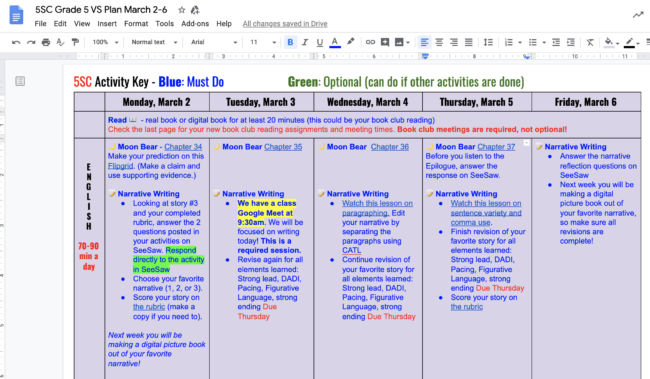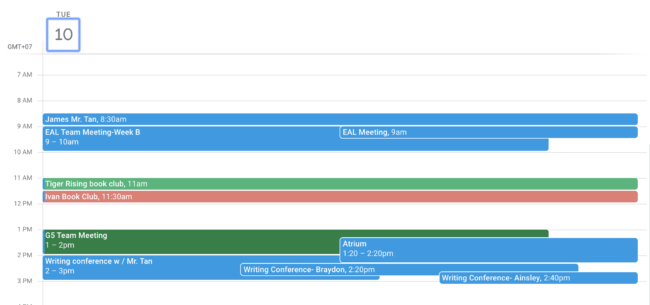Due to the increasing number of schools and districts offering distance learning or virtual school in response to the COVID19 outbreak, I wanted to share how my school is structuring online learning for students. This is not an article directly related to working with language learners, but the suggestions can certainly be applied to working with them.
There are numerous ways to structure online learning, and I would like to share how we have structured it within our international, private school context. Readers of this article will still find it helpful even if they are offering just a one-to-one program. These structures work for us because all of our students have internet access at home. You will have to adapt it to your school context if students do not have internet access outside of school.
We have been offering virtual school since February 3rd, 2020, and, like many others, we did not have time to prepare students or families on how to navigate this new collective reality. We are now entering our 7th week of virtual learning, and these structures have been the ones that have been the most successful for us.
The key is to remember that a virtual school is built on the same blocks that support a physical school . The how of virtual school looks different, but the why must remain the same.
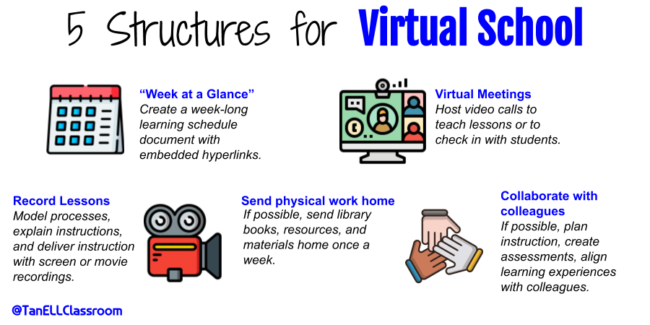
For us, that means:
- prioritizing curriculum planning
- investing in relationships with students, colleagues, and families
- intentionally integrating technology when appropriate
You will see these three foundational blocks in the five structures I share in this article.
1. Create a Week-at-a-Glance document
I suggest creating a document that houses all the work students are supposed to do for the entire week. We did not do this initially as we thought virtual schooling was going to be just a two-week experience. As a result, students, teachers, and families were drowning in a flood of links and documents.
We then created a Week-at-a-Glance document for each class to display all of the assignments for the week. Where applicable, we embedded links to videos, assignments, and other documents. Both students and families appreciated this document as it provided a big picture of the week ahead. By anchoring to this document, they could design their days ahead of time, which gave them a sense of control over the unexpected transition.
Click on the document to get your own copy of the Week-at-a-glance document. You will have to delete the things we have to create your own.
2. Host office hours
In my grade, we have blocked off 9 AM to 11 AM as teacher office hours. We scheduled our online conferences with students at these times using Google Meet. The teachers in my grade have used this time to:
- Model instruction
- Teach content
- Gauge student wellness
- Host book clubs
- Provide small group or individual tutoring
Because the office hours are at a consistent time, students became used to the schedule fairly quickly and families appreciated how it structured the day. Any activities they wanted to plan with their children, they could do so after 11 AM.
Since interviewing flipped learning guru Caitlin Tucker on my podcast, I have changed my office hours to be synchronous learning experiences. Three times a week, I host a live class, and students attend at the same time. I greet each student and check-in with the early arrivals. Once everyone is there (or after 3 minutes of greetings), I send them to different breakout groups. In each group, there are no more than 3 students. Students share their laptop screens with each other and watch the welcome video, which recaps yesterday’s lesson and gives the instructions for today’s collaborative assignment. The assignments rotate between synthesizing a content-based video, annotating a text, or co-authoring a piece of writing. I pop in and out of the groups to check in on students. If students need me, they return to the main virtual room where I welcomed them. We use that room to troubleshoot or hold conferences.
The key to virtual learning is not losing the personal element of an in-person classroom. With frequent and weekly online conferences, students retain some semblance of the learning community that made their school so special.
3. Collaborate with colleagues
At no other time in my teaching career has collaborating with colleagues been so essential to students, families, and our collective well-being. We have made it a point to block 1 PM to 2 PM on Tuesdays and Thursdays to collaborate. We use this time to divide the work, share strategies, and support each other. One of the key deliverables from these meetings is a completed Week-at-a-Glance document for the following week.
At these meetings, the language specialist can provide strategies that would work for language learners or team up with another colleague to make virtual learning more accessible for them.
For the past six weeks, we have been coming to school and have been maintaining regular school working hours. As of March 17, we have been directed to facilitate virtual learning off-site. We will continue to collaborate but will now do so virtually on Zoom.
As we go to virtual teacher collaboration, we anticipate that the Week-at-a-Glance document will structure our online collaboration even more directly than it has in previous weeks.
You might also enjoy The Distance Learning Playbook, Grades K-12: Teaching for Engagement and Impact in Any Setting by renowned education leaders, Dr. Douglas Fisher, Dr. Nancy Frey, and Dr. John Hattie. I read it, and it provided great reminders and strategies on how to structure our online learning experiences.
You might also enjoy my podcast conversation with Dr. Fisher on his co-authored book.
4. Leverage Technology
Technology has provided a means to teach content and facilitate student engagement in this world-wide distance learning environment. These are my most used programs to facilitate virtual learning:
- Screencastify: Create a slide deck or a document used to teach a lesson. Record yourself narrating the slides or document. Send the video to students.
- Edpuzzle: Embed comprehension questions or audio notes in a video recording. As students watch the video, the embedded question or audio note will appear and either play your message or ask them to answer a question. On the dashboard, you can check the students’ responses.
- Google Suite: We are using many of the products on the Google Suite such as Google Classroom, Docs, Slides, Drawing, and Forms to help students demonstrate their understanding and teachers to share content.
- Non-Google Suite creation apps:
- Book Creator – users can publish their writing electronically
- Flipgrid – users can record video responses
- Buncee – users can create a presentation and infographics
- Adobe Spark – users can create animated videos, graphics, web pages
Because I work in Vietnam, we cannot use Talking Points, but if I was in the U.S. or Canada and my school moved to distance learning, I would definitely use it to communicate with families.
Talking Points allows
- Teachers to send free SMS messages to families in English.
- Families to receive these messages in their home language.
- Families to respond to the teacher by texting in their home language.
- Teachers to receive the translated SMS messages in English.
The program allows you to communicate in 100+ languages! THAT’S AMAZING!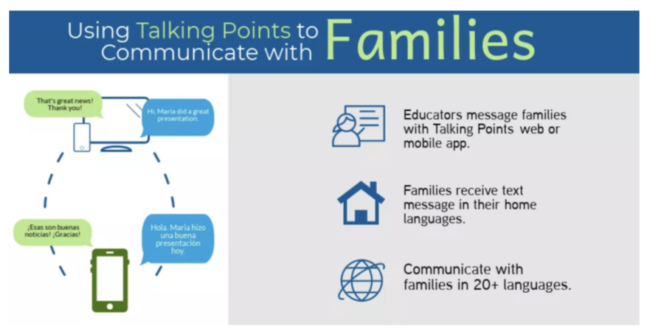
5. Send physical work home
Every two weeks, we send physical packets of work home. Families come to school and pick up the packets for their children. This might be an option for schools where teachers are still allowed to come to school to work. Additionally, this method might help families who do not have internet access at home. The contents of the packet can also align with the assignments on the Week-at-a-Glance document.
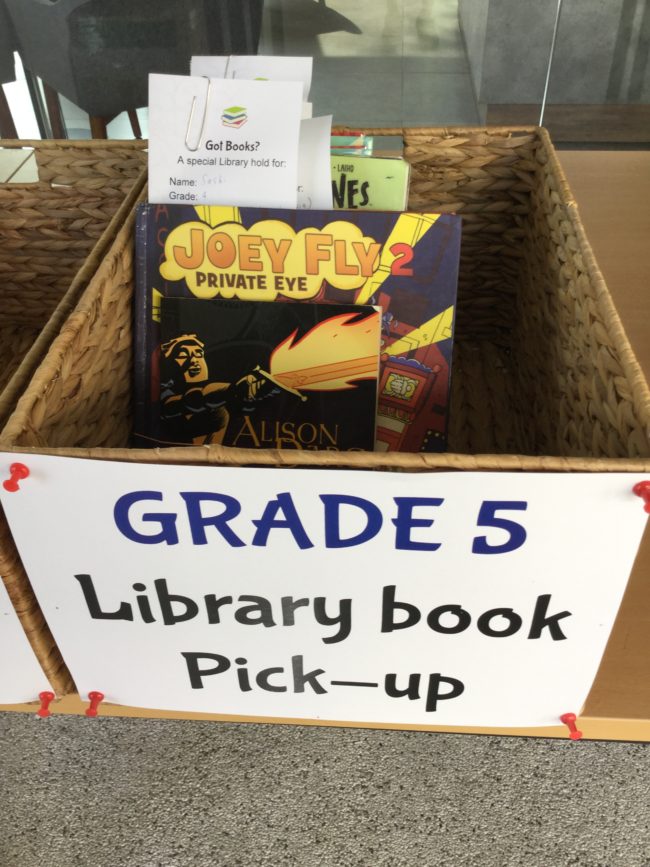
My school organizes library book pick-up to keep students engaged in reading.
We are creating the plane as we’re flying, but I hope the lessons we have gleaned from our seven weeks of virtual learning can be of service to you and your district. If you have suggestions or ideas, please share them with me on Twitter @TanELLClassroom.
May you, your family, and your school family stay safe and healthy in these demanding times. You’re not alone! I’m right there with you!

